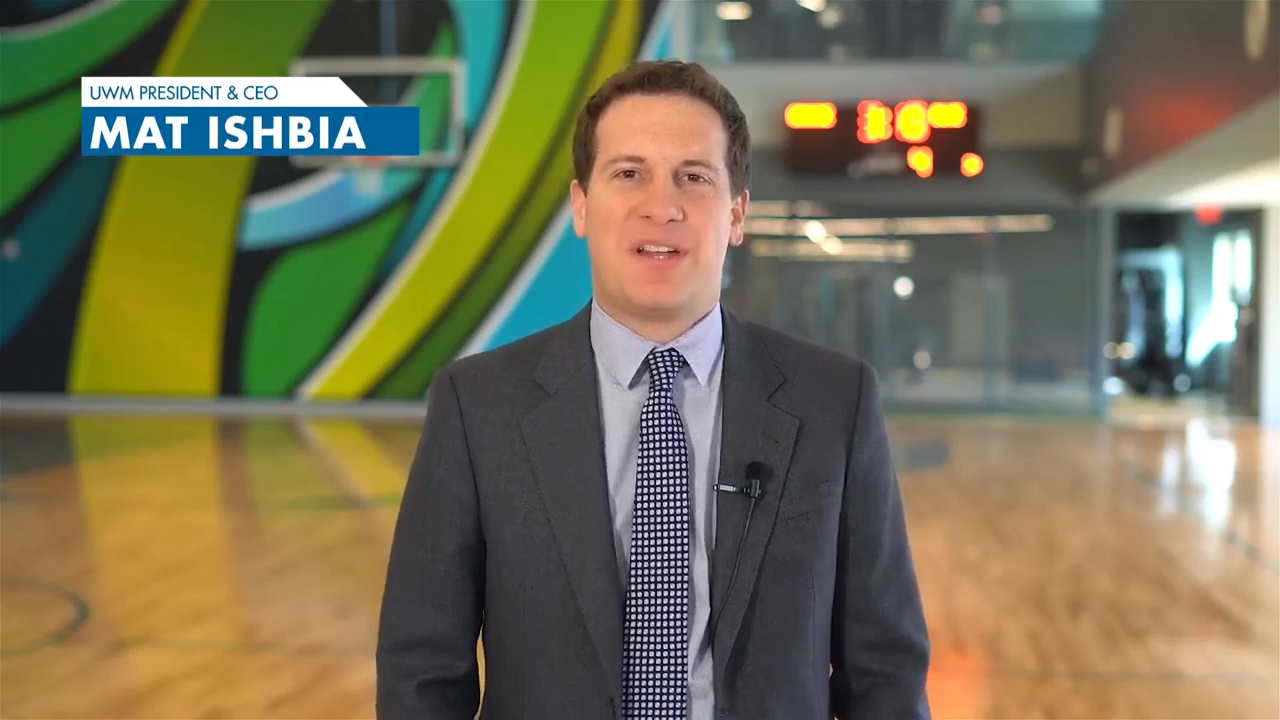-
 The Latest Trend in Mortgage Originating: Leveraging Digital Platforms for Enhanced Efficiency
The Latest Trend in Mortgage Originating: Leveraging Digital Platforms for Enhanced Efficiency Discover how digital platforms are transforming mortgage originating processes, enhancing efficiency, reducing processing times, and personalizing customer experiences.
Discover how digital platforms are transforming mortgage originating processes, enhancing efficiency, reducing processing times, and personalizing customer experiences.
Ishbia on FHA, Fannie Loan Guidelines, Fed Watching, CFPB Acts to Reassure Marketplace
- Monday, 01 April 2019
- Originating

https://youtu.be/kEx6UPx99Wg
Hi there, I’m Mat Ishbia, president and CEO of UWM, and this is “Three Points.”
First point, big FHA changes, so on March 18, 2019, FHA made some big changes for all case numbers after that date. Basically they said, ‘listen we're going to approve a lot less loans for higher DTIs and cash-out refinances.’
So all case numbers after that date the total scorecard their automated system is not giving as many approved eligible and a lot more things are being referred eligible.
Now you can still do some these loans with manual underwriting, but those 50, 55 DTI loans with lower credit scores are not getting approved eligible. Now, FHA still approves a lot of loans; there's a lot of great opportunity on FHA program, but they definitely tightened it up as of March 18th.
[adbutler zone_id="326324"]
[adbutler zone_id="326327"]
Also, Fannie Mae did a similar thing a little bit ago also on their DU 10.30 , so DTIs over 45 percent are less likely toget approved. So the debt to income ratio is tighter in the industry now than it was six ,12, 18-months ago, so we should all be aware of those changes.
Second point, there was a major Fed announcement, so we all know what happened March 20th where the Fed came out and said that basically no rate increase going forward for the rest of 2019. In they were saying it’s a 30 percent chance that they're going to raise rates in
Now, they're saying it's a zero percent chance and actually a third of the people think they might even lower rates this year or the beginning of next year. That's a major swing from what we all would have expected. Now what happened? The ten-year dropped, the 30-year fixed rate dropped. You guys all know that; you live it every single day. Big opportunity on refinances, big opportunity for purchases incoming.
So, maybe rates won't get moved up again until 2021, which is a big change from what we all just thought three, six, nine months ago. So major change, major opportunity--take advantage of it.
Third point, the CFPB reassures the industry.
The new leader of the CFPB, Kathy Kraninger, came out with a big announcement basically saying, “Hey listen I'm not going to abruptly make any changes to the so-called GSE patch.
The patch, as you guys know, is a big deal because anything over 43 DTI is considered Non-QM, unless it's going to the GSEs. And, so if they made that change, anything over 43 DTI would be Non-QM and have a whole different set of rules, and so it's a big deal to keep the patch in place. It was set to expire in 2021, or if it comes out of conservatorship, the GSEs.
But, right now it looks like Kathy Kraninger understands the details and is going to hold on that and make sure she does not affect the industry in a negative way. That's positive news for all homebuyers and everyone in this industry.
Thanks for joining me. I’m Mat Ishbia, president and CEO of UWM, and that was Three Points.
Read more...
Are You Marketing to Past Clients Effectively?
- Thursday, 28 March 2019
- Originating

By Pat Sherlock
During a recent sales audit for a mortgage lender, I asked originators if they marketed to previous customers. They responded that their company sent out birthday and anniversary cards automatically through a CRM system. Everyone felt this effort was enough to generate referrals. Many of the producers also said they didn’t have time to do anything else since they were working on their current production.
What I found striking about these conversations is that there was no recognition that past clients represent an important opportunity for originators and should be an integral component of prospecting initiatives.
At one time, sending greeting cards was a unique and personal touch, but today everyone uses CRM systems to reach out to past customers. As a result, consumers no longer view these communications as special since the process is automated with preprinted signatures. While it is better than not doing anything, these efforts aren’t enough to move the sales needle by generating new referrals.
[adbutler zone_id="326324"]
[adbutler zone_id="326327"]
Many originators have lost sight that doing the same things that everyone else is doing is not going to wow prospects or distinguish them from the competition. Computer-generated mass mailings with just a name changed telegraphs to the customer: “You are really not that important. I am busy, so here you go.”
Is it any wonder that pre-programmed follow-up programs don’t generate referrals? What is missing is a personalized effort that conveys the originator truly cares about their previous clients and what matters most to them.
While many originators complain they don’t have time to market to past customers, focusing a small part of the work week on this influential group can pay off in the long run. Inevitably, customers or their friends and family members will purchase a new home or refinance an existing loan at some point in the future. If producers have not developed or maintained a personal relationship with these customers, they will miss out on any referral business.
Top producers understand that they need at least a third of their volume coming from former customers and their referrals. If an originator doesn’t have that as a base, it is difficult to be 100 percent dependent on sourcing only new customers.
Originators should recognize that past customers represent a potential income stream that can make all the difference in production results when business is challenging. However, it takes effort, planning, strategy and implementation to effectively generate business from past clients.
About the Author: Pat Sherlock is the founder of QFS Sales Solutions, an organization that help sales organizations improve their sales talent management and performance. For more information, visit https://patsherlock.com
Read more...
Fannie Mae: 2019 Economic Growth Slowing
- Friday, 22 March 2019
- Originating

Full-year real GDP growth is estimated to come in at 2.2 percent in 2019, unchanged from the prior forecast but down markedly from 2018’s 3.1 percent, according to the Fannie Mae Economic and Strategic Research Group’s March outlook.
The expected deceleration in growth is attributable to the fading fiscal impact from the Tax Cuts and Jobs Act, as well as continued sluggishness in business investment and consumer spending. Economic growth in the first quarter of 2019 is forecasted to slow to 1.3 percent--in part due to consumer caution following significant volatility in households’ financial assets in the fourth quarter.
Also, the ESR Group noted that risks to its forecast exist on the downside, including slower global growth and ongoing U.S.-China trade uncertainty, but that sustained improvement in productivity and the central bank policy response to fourth quarter volatility will play an important role in shaping the full growth picture.
[adbutler zone_id="326324"]
[adbutler zone_id="326327"]
The ESR Group continues to expect home sales to stabilize in 2019, with housing demand supported by a solid labor market and strong household formation. Affordability, too, has improved by slowing house price appreciation and more attractive mortgage rates. Purchase mortgage originations are expected to expand in 2019 while refinancings contract.
[caption id="attachment_9271" align="alignleft" width="300"] Doug Duncan[/caption]
Doug Duncan[/caption]
“We expect headline growth in the first quarter of 2019 to fall to 1.3 percent annualized--the slowest quarterly growth in over three years,” said Doug Duncan, Fannie Mae’s chief economist. “Growth is clearly on the decline, in line with our projection for 2.2 percent in 2019. As we weigh the downside risks to the economy, including moderating international growth and trade uncertainty, we now project that the Fed will wait until the fourth quarter to raise rates, if at all. However, some ground may have been broken on a path to improved growth, as productivity rose by 1.8 percent annually last quarter--a clear step above the well-trodden 1.0 to 1.4 percent band of the last few years.
“We continue to expect another year of steady home sales in 2019,” Duncan continued. “While inventory has improved, it remains low by historical standards, particularly among existing homes, and threatens to derail the spring home buying season, though a recent jump in single-family starts suggests that new supply is on the way. Considering the general inventory shortage and strong demand for housing, affordability remains a key challenge facing the industry, particularly in the conforming space.”
Read more...OCC Hits Citibank with $25M Fine for Fair Housing Act Violations
- Wednesday, 20 March 2019
- Originating

| The Office of the Comptroller of the Currency assessed a $25 million civil monetary penalty against Citibank for violations of the Fair Housing Act.
The OCC determined that the bank lacked proper control over the Relationship Loan Pricing program-- designed to provide eligible mortgage loan customers either a credit to closing costs or an interest rate reduction. As a result of these control weaknesses, some bank borrowers did not receive the Relationship Loan Pricing benefit for which they were eligible and were adversely affected on the basis of their race, color, national origin, or sex, violating the Fair Housing Act, according to the Consent Order from the OCC. The bank has initiated and largely completed a plan to reimburse all customers who did not receive the appropriate RLP benefit, including those customers affected by these violations, and is taking other appropriate corrective action to prevent future violations. The bank will reimburse 24,000 customers a $1,000 each in addition to the civil monetary penalty. [adbutler zone_id="326324"] [adbutler zone_id="326327"] |
According to the Consent Order, in August 2011, the bank piloted a Relationship Loan Pricing program and in February 2012, implemented it across its customer base. Under the program, qualified customers could receive a credit for closing costs or an interest-rate reduction.
Citibank failed to ensure effective risk management and internal controls, including inadequate periodic reviews, over the Relationship Loan Pricing program, including:
- From August 2011 to April 2015, Citibank failed to provide adequate training to loan officers regarding how to offer Relationship Loan Pricing to customers.
- In addition, between August 2011 to November 2014, written guidelines did not explicitly instruct loan officers to offer Relationship Loan Pricing to all eligible customers and the bank didn’t require loan officers to document the basis for the customer’s rejection.
- Also, between August 2011 to January 2015, Citibank didn’t require loan officers to inform customers of all discount programs for which they might qualify.
- As a result of ineffective risk management and control weaknesses, some bank borrowers didn’t receive the Relationship Loan Pricing benefit for which they were eligible and were adversely affected on the basis of their race, color, national origin or sex. After determining in 2014 that some customers hadn’t received the correct Loan Pricing benefit, Citibank self-reported its findings to the OCC in 2015.
Read more...







